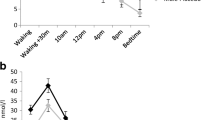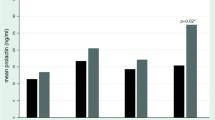Abstract
Rationale
Several previous neuroendocrine studies have demonstrated reduced 5-HT1A receptor function in major depressive disorder (MDD). However, hypercortisolaemia or previous drug treatment may have been significant confounds.
Objectives
To replicate previous studies in subjects with MDD who had been drug free for at least 8 weeks and to relate the findings to measures of HPA axis function.
Methods
Hormonal responses to l-tryptophan infusion were measured in patients with MDD (n=20) and healthy controls (n=20). Basal salivary cortisol and DHEA were also profiled.
Results
No attenuation of 5-HT1A receptor-dependent neuroendocrine responses (growth hormone, prolactin) was observed in patients with MDD. The prolactin response to l-tryptophan was significantly greater in MDD patients than in healthy controls (P=0.008). There was a significant negative correlation between prolactin response and basal salivary cortisol secretion over the 3 days prior to the test.
Conclusions
These data do not support previous findings of reduced 5-HT1A function in MDD and suggest that hypercortisolaemia or psychotropic medication may have accounted for the attenuation. Basal cortisol, DHEA and the cortisol-DHEA ratio did not differ between patients and controls, and all patients were psychotropic medication-free. The greater prolactin response to l-tryptophan infusion in depressed subjects may be the result of an increase in dopamine receptor sensitivity, secondary to reduced dopamine levels.

Similar content being viewed by others
References
Anderson IM, Cowen PJ (1991) Prolactin response to the dopamine antagonist, metoclopramide, in depression. Biol Psychiatry 30:313–316
Chaouloff F (1995) Regulation of 5-HT receptors by corticosteroids: where do we stand? Fundam Clin Pharmacol 9:219–233
Chaouloff F (2000) Serotonin, stress and corticoids. J Psychopharmacol 14:139–151
Charney DS, Heninger GR, Reinhard JF, Jr, Sternberg DE, Hafstead KM (1982) The effect of IV l-tryptophan on prolactin, growth hormone, and mood in healthy subjects. Psychopharmacology 78:38–43
Checkley SA (1980) Neuroendocrine tests of monoamine function in man: a review of basic theory and its application to the study of depressive illness. Psychol Med 10:35–53
Cowen PJ, Charig EM (1987) Neuroendocrine responses to intravenous tryptophan in major depression. Arch Gen Psychiatry 44:958–966
Deakin JF, Pennell I, Upadhyaya AJ, Lofthouse R (1990) A neuroendocrine study of 5HT function in depression: evidence for biological mechanisms of endogenous and psychosocial causation. Psychopharmacology 101:85–92
Deakin JFW, Graeff FG (1991) 5-HT and mechanisms of defence. J Psychopharmacol 5:305–315
Drevets WC, Frank E, Price JC, Kupfer DJ, Holt D, Greer PJ, Huang Y, Gautier C, Mathis C (1999) PET imaging of serotonin 1A receptor binding in depression. Biol Psychiatry 46:1375–1387
Goodwin GM, De Souza RJ, Green AR (1985) Presynaptic serotonin receptor-mediated response in mice attenuated by antidepressant drugs and electroconvulsive shock. Nature 317:531–533
Haleem DJ (1992) Repeated corticosterone treatment attenuates behavioural and neuroendocrine responses to 8-hydroxy-2-(di-n-propylamino) tetralin in rats. Life Sci 51:225–230
Heninger GR, Charney DS, Sternberg DE (1984) Serotonergic function in depression. Prolactin response to intravenous tryptophan in depressed patients and healthy subjects. Arch Gen Psychiatry 41:398–402
Joels M, Hesen W, de Kloet ER (1991) Mineralocorticoid hormones suppress serotonin-induced hyperpolarization of rat hippocampal CA1 neurons. J Neurosci 11:2288–2294
Kalimi M, Shafagoj Y, Loria R, Padgett D, Regelson W (1994) Anti-glucocorticoid effects of dehydroepiandrosterone (DHEA). Mol Cell Biochem 131:99–104
Koyama T, Meltzer HY (1986) A biochemical and neuroendocrine study of the serotonergic system in depression. In: Hippius H, Klerman GL, Matussek N (eds) New results in depression research. Springer, Berlin, pp 169–188
Lesch KP, Disselkamp-Tietze J, Schmidtke A (1990) 5-HT1A receptor function in depression: effect of chronic amitriptyline treatment. J Neural Transm [Gen Sect] 80:157–161
Lesch KP, Hoh A, Schulte HM, Osterheider M, Muller T (1991) Long-term fluoxetine treatment decreases 5-HT1A receptor responsivity in obsessive-compulsive disorder. Psychopharmacology 105:415–420
Lupien S, Richter R, Risch SC, Mirow A, Gillin JC, Hauger RL (1995) Time course of the corticosteroid-dopaminergic interaction during metyrapone and dexamethasone administration. Psychiatry Res 58:23–35
Marshall EF, Kennedy WN, Eccleston D (1987) Whole blood serotonin and plasma tryptophan using high-pressure liquid chromatography with electrochemical detection. Biochem Med Metab Biol 37:81–86
Meltzer HY, Maes M (1995) Effects of ipsapirone on plasma cortisol and body temperature in major depression. Biol Psychiatry 38:450–457
Meyer JH, Kruger S, Wilson AA, et al. (2001) Lower dopamine transporter binding potential in striatum during depression. Neuroreport 12:4121–4125
Monteleone P, La Rocca A, Fuschino A, Bortolotti F, Maj M (1999) Seasonal variation in plasma prolactin response to d-fenfluramine in healthy subjects. Psychoneuroendocrinology 24:201–208
Murphy BE (1991) Steroids and depression. J Steroid Biochem Mol Biol 38:537–559
Naess O, Haug E, Gautvik K (1980) Effects of glucocorticosteroids on prolactin and growth hormone production and characterization of the intracellular hormone receptors in rat pituitary tumour cells. Acta Endocrinol (Copenh) 95:319–327
Naranjo CA, Tremblay LK, Busto UE (2001) The role of the brain reward system in depression. Prog Neuropsychopharmacol Biol Psychiatry 25:781–823
Nelson JC, Davis JM (1997) DST studies in psychotic depression: a meta-analysis. Am J Psychiatry 154:1497–1503
Porter RJ, McAllister-Williams RH, Lunn BS, Young AH (1998) 5-Hydroxytryptamine receptor function in humans is reduced by acute administration of hydrocortisone. Psychopharmacology 139:243–250
Porter RJ, McAllister-Williams RH, Jones S, Young AH (1999) Effects of dexamethasone on neuroendocrine and psychological responses to l-tryptophan infusion. Psychopharmacology 143:64–71
Porter RJ, Gallagher P, Watson S, Lunn BS, Young AH (2002) Effects of sub-chronic administration of hydrocortisone on hormonal and psychological responses to l-tryptophan in normal male volunteers. Psychopharmacology 163:68–75
Power AC, Cowen PJ (1992) Neuroendocrine challenge tests: assessment of 5-HT function in anxiety and depression. Mol Aspects Med 13:205–220
Price LH, Charney DS, Delgado PL, Heninger GR (1991) Serotonin function and depression: neuroendocrine and mood responses to intravenous l-tryptophan in depressed patients and healthy comparison subjects. Am J Psychiatry 148:1518–1525
Raap DK, Garcia F, Muma NA, Wolf WA, Battaglia G, van de Kar LD (1999) Sustained desensitization of hypothalamic 5-hydroxytryptamine1A receptors after discontinuation of fluoxetine: inhibited neuroendocrine responses to 8-hydroxy-2-(dipropylamino)tetralin in the absence of changes in Gi/o/z proteins. J Pharmacol Exp Ther 288:561–567
Riedel WJ, Klaassen T, Griez E, Honig A, Menheere PP, van Praag HM (2002) Dissociable hormonal, cognitive and mood responses to neuroendocrine challenge: evidence for receptor-specific serotonergic dysregulation in depressed mood. Neuropsychopharmacology 26:358–367
Roth M, Gurney C, Mountjoy CQ (1983) The Newcastle rating scales. Acta Psychiatr Scand 68:42–54
Rothschild AJ, Langlais PJ, Schatzberg AF, Walsh FX, Cole JO, Bird ED (1984) Dexamethasone increases plasma free dopamine in man. J Psychiatr Res 18:217–223
Rupprecht R, Rupprecht C, Rupprecht M, Noder M, Lesch KP, Mossner J (1989) Effects of glucocorticoids on the regulation of the hypothalamic-pituitary-somatotropic system in depression. J Affect Disord 17:9–16
Sargent P, Williamson DJ, Pearson G, Odontiadis J, Cowen PJ (1997) Effect of paroxetine and nefazodone on 5-HT1A receptor sensitivity. Psychopharmacology 132:296–302
Sargent PA, Kjaer KH, Bench CJ, Rabiner EA, Messa C, Meyer J, Gunn RN, Grasby PM, Cowen PJ (2000) Brain serotonin1A receptor binding measured by positron emission tomography with [11C]WAY-100635: effects of depression and antidepressant treatment. Arch Gen Psychiatry 57:174–180
Schatzberg AF, Rothschild AJ, Langlais PJ, Bird ED, Cole JO (1985) A corticosteroid/dopamine hypothesis for psychotic depression and related states. Psychiatry Res 19:57–64
Shah PJ, Ogilvie AD, Goodwin GM, Ebmeier KP (1997) Clinical and psychometric correlates of dopamine D2 binding in depression. Psychol Med 27:1247–1256
Shirtcliff EA, Granger DA, Schwartz E, Curran MJ (2001) Use of salivary biomarkers in biobehavioral research: cotton-based sample collection methods can interfere with salivary immunoassay results. Psychoneuroendocrinology 26:165–173
Smith CE, Ware CJ, Cowen PJ (1991) Pindolol decreases prolactin and growth hormone responses to intravenous l-tryptophan. Psychopharmacology 103:140–142
Tremblay LK, Naranjo CA, Cardenas L, Herrmann N, Busto UE (2002) Probing brain reward system function in major depressive disorder: altered response to dextroamphetamine. Arch Gen Psychiatry 59:409–416
Upadhyaya AK, Pennell I, Cowen PJ, Deakin JF (1991) Blunted growth hormone and prolactin responses to l-tryptophan in depression; a state-dependent abnormality. J Affect Disord 21:213–218
van Praag HM, Lemus C, Kahn R (1987) Hormonal probes of central serotonergic activity: do they really exist? Biol Psychiatry 22:86–98
Verbeeck WJC, Berk M, Paiker J, Jersky B (2001) The prolactin response to sulpiride in major depression: the role of the D2 receptor in depression. Eur Neuropsychopharmacol 11:215–220
Wachtel SR, Charnot A, de Wit H (2001) Acute hydrocortisone administration does not affect subjective responses to d-amphetamine in humans. Psychopharmacology 153:380–388
Watson S, Porter RJ, Young AH (2000) Effect of hydrocortisone on the pituitary response to growth hormone releasing hormone. Psychopharmacology 152:40–46
Watson S, Gallagher P, Smith MS, Hearn AJ, Young AH (2002) The effects of sub-chronic administration of hydrocortisone on the responses to amphetamine. Int J Neuropsychopharmacol 5:S156–157
Wolkowitz OM, Sutton ME, Doran AR, Labarca R, Roy A, Thomas JW, Pickar D, Paul SM (1985) Dexamethasone increases plasma HVA but not MHPG in normal humans. Psychiatry Res 16:101–109
Wurtman RJ (1982) Nutrients that modify brain function. Sci Am 246:50–59
Young AH, Gallagher P, Porter RJ (2002) Elevation of the cortisol-dehydroepiandrosterone ratio in drug-free depressed patients. Am J Psychiatry 159:1237–1239
Acknowledgements
We thank all participants. We also thank D. Nelson and M. Leitch for their technical assistance and A. Stals for preparation of the manuscript.
Author information
Authors and Affiliations
Corresponding author
Rights and permissions
About this article
Cite this article
Porter, R.J., Gallagher, P., Watson, S. et al. Elevated prolactin responses to l-tryptophan infusion in medication-free depressed patients. Psychopharmacology 169, 77–83 (2003). https://doi.org/10.1007/s00213-003-1475-1
Received:
Accepted:
Published:
Issue Date:
DOI: https://doi.org/10.1007/s00213-003-1475-1




